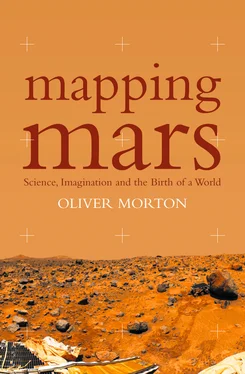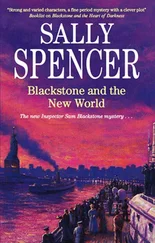Gene Shoemaker’s thinking on terrestrial topography, which would find application in the interpretation of form on the moon and beyond, took place in large part on the Colorado Plateau which Gilbert had known so well (indeed, he had given it its name). In 1948, twenty years old and with a Caltech degree in geology already behind him, Shoemaker joined the US Geological Survey and found himself working in southern Colorado. He discovered that he loved the landscapes of the south-west. He loved the pines, he loved the open spaces, he loved the great, vaulting skies. He stared up at the desert moon with wonder.
In the field, he did not have much contact with the rest of the world. But he did get the Caltech alumni newspaper, which revealed that experiments with captured V2 rockets elsewhere in New Mexico were reaching the very edge of the atmosphere. It was a revelation. ‘Why, we’re going to explore space,’ he later remembered thinking, ‘and I want to be part of it! The moon is made of rock, so geologists are the logical ones to go there – me, for example.’
Shoemaker kept his wild dream to himself – a decade before Sputnik there was little call for space age geology. The atomic age, though, needed geologists badly. Cold War strategy required that America develop reliable domestic sources of uranium, and the Colorado Plateau was thought likely to hold the reserves required. So in his first years with the USGS Shoemaker joined in the last great American mining boom; at the same time he started work on a Ph.D at Princeton and got married. He criss-crossed the Colorado Plateau from site to site, ‘half man, half jeep’, according to his wife, Carolyn, who often accompanied him. It wasn’t normal for geologists’ wives to come along on field trips, but the Shoemakers didn’t care. When they had children, the children came too.
All the while, Shoemaker kept thinking about the moon. He read everything there was to read on the subject, including Grove Karl Gilbert; he tailored his fieldwork to suit his extraterrestrial interests. It was this which led him to map diatremes in the Painted Desert’s Hopi Buttes. Diatremes are volcanic features, chimneys of magma that rise to the surface causing explosions, which throw out a lot of normally well-buried rock and comparatively little lava; they can create the low-lying craters called maars to whose number Gilbert had added Meteor Crater. As a uranium prospector, Shoemaker was interested in diatremes because the rocks they threw out when they cleared their throats might be from uranium-bearing strata. As a would-be lunar geologist, he was interested in them because their associated craters often occur in families laid out along a straight line; many lunar craters show a similar linear tendency. Diatremes might thus be analogies by which to understand some forms of volcanism on the moon.
Shoemaker caught his first fleeting glimpse of Meteor Crater in the late summer of 1952. One afternoon, driving past the town of Winslow, he convinced his wife and a colleague that the site to which the great Grove Karl Gilbert had devoted his time might be worth a look. They didn’t have the entrance fee required for the public viewing platform on the north edge of the crater, so they had to take an indirect approach via a dirt track and then scramble up the rim. By the time they got to the top, the sun was setting and most of the great bowl was already in twilight. They stayed only a few minutes and Shoemaker saw nothing to contradict Gilbert’s assessment. In a few years, though, he would. A landscape that was only then being brought into existence gave Shoemaker the analogy he needed to understand Meteor Crater.
By the mid-1950s the American uranium rush had uncovered deposits of the stuff large enough to meet any plausible need. Plutonium, though, was another matter. Natural plutonium exists in only the most tiny of quantities, on the order of a kilogram per planet or so. If you want to make bombs of plutonium – which has a number of advantages over the use of uranium – you first have to produce the stuff. This is normally done with the help of a nuclear reactor which breeds plutonium from uranium. However, in the mid-1950s a quicker alternative started to be discussed: simply wrapping nuclear weapons in now plentiful uranium and setting them off somewhere where their blasts would be contained. Neutrons given off in the explosion would turn some of the mantling uranium into plutonium, which could then be scraped up and put into more bombs.
A necessary part of this alarming scheme was finding places where you could set off nuclear bombs without the debris being scattered to kingdom come. One possibility was salt caverns; since Shoemaker’s Princeton work dealt with salt structures in southern Utah, he was called on to look into the question. As a result, he saw what few other geologists had had the chance to see; a pair of craters at the Atomic Energy Commission’s Nevada test site that had been formed by underground nuclear explosions, craters called Teapot Ess and Jangle U. The shapes of the craters, he learned, were determined by the interplay of various sets of shock waves, some heading out from the bomb, some bouncing back. The nuclear-testing fraternity had a keen understanding of shock waves; a correct calculation of the behaviour of the shock waves inside their bombs was the key to getting them to go off properly in the first place. So Shoemaker learned of the power of shock waves both from the physicists and from the craters themselves, their edges deformed by enormous pressures, the sand around them fused to glass.
When Shoemaker went back to Meteor Crater in 1957 it was not directly because of his new experience in matters nuclear (he advised the bomb makers, incidentally, that keeping explosions contained underground was not going to work). But that new experience changed the way he saw the crater; now it looked like the aftermath of something like a nuclear explosion, something formed by shock waves in a matter of seconds. He set about making a systematic study – a process which required that he make friends with its owners, the Barringer family. In the early decades of the twentieth century Daniel Barringer, a lawyer and mining engineer, spent a lot of time trying to convince people that the crater had been formed by an impact, and a lot of money trying to mine its floor for the huge and valuable lump of pure iron he expected to find there. His failure to convince the world that it was even worth looking for such iron was in part due to the fact that no less an authority than G. K. Gilbert had disagreed with the idea. Barringer’s heirs had inherited both a largely useless crater and a dislike of geologists from the Survey. Shoemaker, though, became their friend and ally, in part because he was introduced to them by their old schoolmaster.
Shoemaker’s work at the crater in the late 1950s both vindicated Daniel Barringer’s insight and revealed his dream to have been illusory. Shoemaker found places where heat had turned sandstones into glass; he mapped inverted strata on the crater’s rim where the lip had been folded back on itself just as the rim of Jangle U had. Most crucially, he and a colleague found that the sandstones in the crater contained coesite, a very dense mineral created when quartz is subjected to extreme pressures. Only transient shock waves of immense power could create such pressures on the scale required: coesite was frozen smoke from the impact’s gun. Meteor Crater was indeed caused by an impact, as Barringer had thought. But the rebounding shock waves that formed the crater had completely exploded the incoming lump of iron he had hoped to profit from. As Gilbert’s volumetric assessments had shown, there was no extraterrestrial motherlode beneath the floor.
While Shoemaker worked to forge this causal link between heavens and earth, a matching connection was being set up in the opposite direction; the first earthly objects were being sent beyond the planet. Exploration of the moon suddenly seemed a practical possibility and Shoemaker was keen that the USGS should grasp it – just as Gilbert would have been. The Survey was keen, too. It had expanded a lot during the search for uranium, and now that that search was over, and the Atomic Energy Commission had withdrawn funding, it was left with more geologists than it had money or jobs for. Shoemaker’s astrogeological dreams might take up the slack – if funding could be found.
Читать дальше












